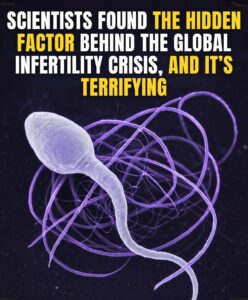Scientists Uncover Startling Link Between Microplastics and Worldwide Fertility Crisis

In what’s becoming an increasingly global concern, birth rates are plummeting across continents. From South Korea and Japan to the United States and much of Europe, more couples are struggling to conceive — despite medical advances and widespread awareness campaigns. While many have long pointed fingers at lifestyle factors like stress, obesity, or age, new findings suggest there’s a far more insidious threat at play.
A Microscopic Enemy in Our Bodies
Recent scientific investigations have begun to reveal a disturbing truth: microplastics — the minuscule particles shed from everyday plastics — are infiltrating not just our food and water, but our very reproductive systems.
In a pivotal 2023 study published in Toxicological Sciences, researchers made a chilling discovery. For the first time, microplastics were identified in both human semen and testicular tissue. Scientists found fragments of polyethylene, polystyrene, and PVC — common components of packaging and synthetic fabrics — embedded in reproductive organs. The presence of these materials raises serious concerns about long-term exposure and its potential to disrupt human fertility on a massive scale.
Mounting Evidence of Reproductive Harm
This human study builds on earlier research in animal models, where microplastic exposure was linked to reduced sperm count, lower testosterone, and in some cases, even testicular shrinkage. Now, with hard evidence of these particles inside human reproductive tissue, the implications are impossible to ignore.
Complementing this, a comprehensive review published in Human Reproduction Update in 2022 highlighted a staggering statistic: global sperm counts have fallen more than 50% in the past five decades — and the pace of decline is accelerating. While factors like diet and stress play a role, they don’t fully account for such a widespread drop. Scientists increasingly point to pollutants like microplastics and hormone-disrupting chemicals as likely culprits.
How Microplastics Undermine Fertility
The harm goes far beyond the physical presence of plastic particles. Microplastics act as carriers for toxic compounds — including phthalates, bisphenol A (BPA), and heavy metals — all of which interfere with the body’s hormonal balance.
Once in the body, these toxins can:
-
Disrupt hormone production, especially testosterone and estrogen
-
Cause oxidative stress, which damages DNA in sperm cells
-
Create inflammation in reproductive tissues, hampering fertility
Emerging evidence also suggests microplastics may negatively affect female reproductive health, potentially disrupting ovulation and early pregnancy — though this area of research is still developing.
An Invisible Invasion: How We’re Exposed
Microplastics have become nearly unavoidable. They’re in our oceans, our homes, and now, alarmingly, in our bodies. Here’s how most people come into contact with them:
-
Drinking bottled water – Studies show over 90% of brands contain microplastic particles
-
Using plastic containers – Especially when reheating food
-
Wearing synthetic clothing – Fibers shed into the air we breathe
-
Eating seafood – Marine animals ingest plastic waste, which accumulates up the food chain
-
Living indoors – Where particles from carpets, upholstery, and dust float in the air
In fact, a 2022 study revealed microplastics in human blood for the first time — highlighting how deeply these pollutants have penetrated our environment.
A Threat to Future Generations
Experts warn that if we don’t address this environmental crisis soon, the implications could be devastating for humanity’s future.
Dr. Shanna Swan, a prominent environmental scientist, cautions that assisted reproduction could become the norm rather than the exception if current trends continue. “We are facing a reproductive emergency,” she says. “And while individual choices do matter, sweeping changes in how we use and dispose of plastic are urgently needed.”
What You Can Do to Minimize Exposure
Although it’s virtually impossible to eliminate microplastic exposure entirely, there are practical steps you can take to reduce your risk:
-
Choose filtered tap water over bottled beverages
-
Avoid microwaving or storing food in plastic containers
-
Wear natural fabrics like cotton and wool
-
Store meals in glass or stainless-steel containers
-
Regularly ventilate your home and use HEPA filter vacuums
Conclusion: A Price Too High for Convenience
The convenience of plastics has come at a steep and unforeseen cost. What once made life easier — disposable containers, synthetic clothing, packaged meals — may now be compromising our ability to bring new life into the world.
This isn’t just a personal health issue. It’s a warning sign for all of humanity. Microplastics don’t disappear when we throw them away. They circle back — in our ecosystems, our bodies, and potentially in our most intimate biology.
If we fail to take action now, future generations may pay the ultimate price.